Calvados to Chartreuse: The ultimate booze map of France
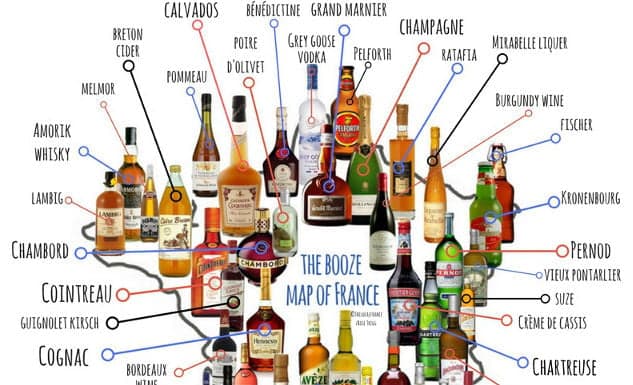
France is well known for its food - but did you realise just how many different types of alcoholic drink the country produces? This may make you want to have an early apéro . . .
There are dozens of good maps of France (from the cheese map to the map that shows how many cheek kisses you should do) - but have you ever seen a good booze map?
We hadn't either, so decided to put one together. We present: The ultimate booze map of France, featuring most famous French tipples (no doubt we might have missed a couple) and a few you may not have heard of, let alone tried.
Of course you can try most of these alcoholic drinks anywhere in France, but we've focused on the area of the country each beverage originated in.
Here's the full map, followed by a closer look at each corner of the country.
(The Local France encourages responsible drinking and would suggest not all of these are sampled during the same apéro)
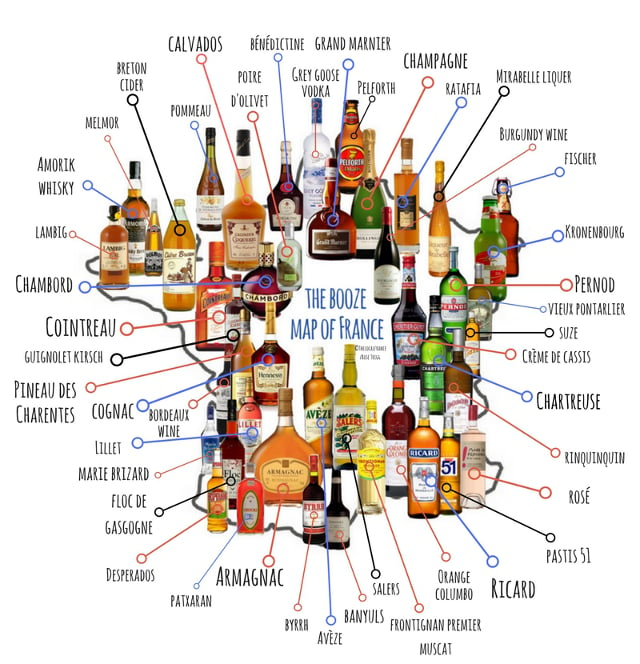 And in case that is all a little overwhelming, let's take it region by region.
Not only does each region of France have its local specialities, you will find that drinking habits vary quite drastically depending on where you are, from the beer and cider-living northern French to the pastis-swilling inhabitants of Marseille and all points in between.
And in case that is all a little overwhelming, let's take it region by region.
Not only does each region of France have its local specialities, you will find that drinking habits vary quite drastically depending on where you are, from the beer and cider-living northern French to the pastis-swilling inhabitants of Marseille and all points in between.
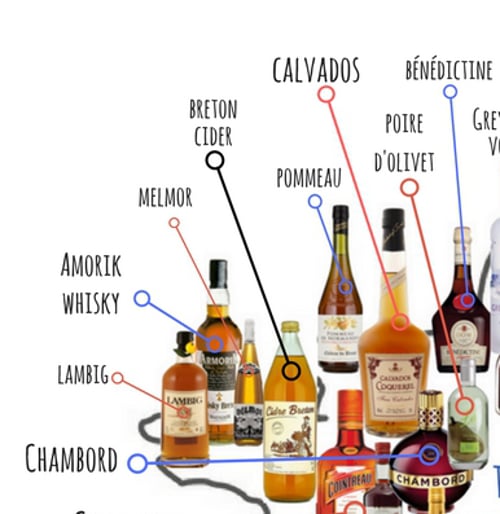
North west and west
Chambord - A popular addition to sweeten Champagne, the raspberry and blackberry liqueur is said to have been created when Louis XIV visited the Chateau de Chambord in the Loire Valley in 1685.
Lambig - Similar to Calvados, the apple brandy is also known in Brittany as "fine Bretagne". The cider is distilled in an alembic, which is from where the name originated.
Amorik Whisky - The Armorik range of whisky offers single malts and blends, made in what one distillery says are the perfect conditions of Brittany: "Our whisky has found a coastal heathland environment perfect for ageing under the best possible conditions. The sea, wind and rain have forged its character that is second to none."
Melmor - Similar to mead, this drink is a simple mix of water, honey, and yeast. If you like a drink with heritage, this one is for you - "The recipe has not changed since the Celts introduced chouchen to Brittany," one distillery claims.
Breton cider - Breton cider needs no introduction. If you're a real fan, take on the route de cidre - a tour of the region's cider makers. Inhabitants of Brittany also have a fierce and long-running dispute with their neighbours in Normandy over whether cider should be drunk from a glass or a cup.
Pommeau and Calvados - Over in Normandy, enjoy apple-based drinks like Calvados apple brandy, or try it mixed with apple juice in Pommeau.
Poire d'olivet - The clear pear brandy from the town of Olivet near Orléans often comes with a whole pear in the bottle.
Benedictine - Here's another Normandy speciality made with apples. The drink is said to have been created by the Benedictine monk Dom Bernado Vincelli in Fécamp Abbey in 1510. The "elixir" recipe was lost for 350 years and re-discovered by Alexander the Great, who named it Bénédictine.
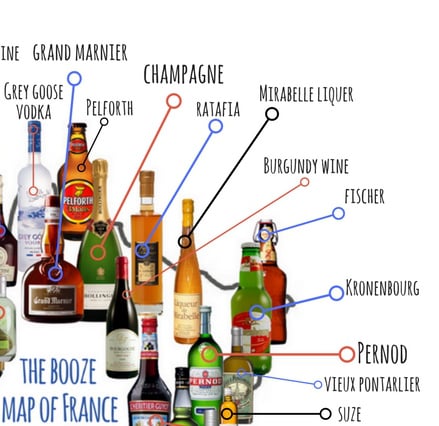
North east
Grey Goose vodka - The famous Grey Goose vodka is distilled in Picardy, close to the Belgian border. Although the drink was created by American Sidney Frank, it uses the soft wheat from the Picardy area and is fermented and distilled in the area before being sent to the Cognac region for bottling. The bottle shows the French flag, just to big-up the brand's French connection.
Grand Marnier - One of France's most successful alcoholic exports, the orange-flavoured liqueur Grand Marnier is made with a blend of Cognac and bitter oranges, coming from from Neauphle-le-Château near Versailles.
Pelforth - This beer, which comes in blonde and brown varieties, originated from Lille and now belongs to the Heineken group.
Champagne - No surprises for guessing where Champagne comes from. All "official" Champagne still comes from the Champagne region of France. The wine collectives of this area employ a team of eagle-eyed lawyers to track down and threaten (with a lawsuit) anyone attempting to market a product with 'Champagne' in its name if it does not contain some product from the area.
Ratafia - Ratafia refers to fortified wines or liqueurs or citrus-peel flavoured liquers. The ratafia from Champagne is the most famous and is of the fortified wine category. It's made with the same grapes as for champagne, but they're allowed to ripen to maturity, dried, and re-hydrated.
Mirabelle liquer - Yellow "mirabelle" plums are a delicacy of the Lorraine region and appear in many local recipes. The plum liqueur is sweet and slightly honey-flavoured.
Burgundy wine - The mineral taste of Burgundy wines comes from the area's limestone soils, formed at a time when Burgundy was part of a tropical sea. The two main Burgundy grapes are Pinot Noir and Chardonnay. Obviously there are too many Burgundy wines to get on this map.
Fischer beer - Ficher beer, in its distinctive corked bottle, is native to Alsace. The Fischer brewery was founded in Strasbourg and moved to Schiltigheim. The north-east of France is the country's beer heartland, although good craft ales are becoming increasingly popular through the rest of the country too.
READ ALSO How France became a nation of beer lovers
Kronenbourg - Another Alsacian beer, Kronenbourg was created in Strasbourg and its 1664 variety is now the most sold French beer in the world.
Pernod - This aniseed liqueur, created around 80 years ago, is one of the hallmarks of French drinking. When served with ice and water the clear liquid turns a cloudy cream colour - and is perfect for a summer's day. Although it's technically not a Pastis.
Vieux Pontarlier - The French absinthe from Pontarlier, close to the Swiss border, is still made using the original recipe. It's made from local wormwood, green anise seeds and fennel seed along with a secret blend of herbs and spices. Fun fact: none of the ingredients in absinthe are hallucinogens and never were.
READ ALSO How the 'absinthe murders' lead to a global ban
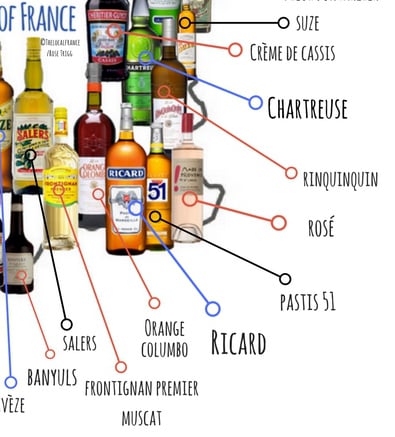 South east
Suze - Often referred to as both a French and Swiss invention, the liqueur is flavoured with the root of genetian plants and is typically enjoyed as an aperitif.
South east
Suze - Often referred to as both a French and Swiss invention, the liqueur is flavoured with the root of genetian plants and is typically enjoyed as an aperitif.
Crème de cassis - The sweet blackcurrant liqueur is a speciality of Burgundy and Dijon in particular. It's normally mixed with white wine to make a Kir. If you mix it with sparkling white wine, that is a kir royale - both drinks are often enjoyed as an apéro.
Chartreuse - Chartreuse boasts that its herbal liqueur is the only one in the world with a completely natural green colour.
The history of Chartreuse is a bit of a mystery, in 1605 a Chartreuse monastery apparently received a gift of an ancient manuscript containing the recipe for the drink. It was sent to the order's main monastery near Grenoble where it was deciphered, recreated and sold as a medicine called "The Elixir of Long Life".
Of course it's possible that this story was dreamed up by a 17th century monk who had a gift for marketing.
Rinquinquin - The Provencal drink is made with peaches, autumnal peach tree leaves, cane sugar and Lubéron white wine. You can drink it as an aperitif with tonic, neat or with ice cubes.
Provence Rosé wine - Many types of wine are made in Provence, but the region is particularly well known for its rosés and is the only wine region to focus on rosé, there's even a rosé research institute. All of which makes Provence the perfect place to visit in the spring and summer, which is rosé season.
Ricard and Pastis - Ricard and Pastis 51 are the leading brands of the Marseille-born star anise and licorice flavoured liqueurs.
Traditionally pastis should be enjoyed one part to five parts water, but as part of a recent re-branding effort to shake off the fusty image of pastis you can ask for a more diluted version with eight parts water called "piscine".
Orange Columbo - The Provencal drink is made with Lubéron rosé, sweet and bitter oranges, bitter bark infusions, curaçao and other flavours.
Frontignan premier muscat - Muscat wines are produced in various regions of France, but Frontignan on the south coast has been famous for its varieties for centuries and it was the first naturally sweet wine label to be officially recognised.
Salers - The liqueur from Auvergne is made from the root of the gentian plant, sweetened with white wine and botanical flavourings.
Banyuls - The natural sweet wines known as Banyuls come from four towns on the Côte Vermeille close to the Spanish border: Banyuls itself, Cerbère, Collioure and Port-Vendres. They are usually drunk as an apéro.
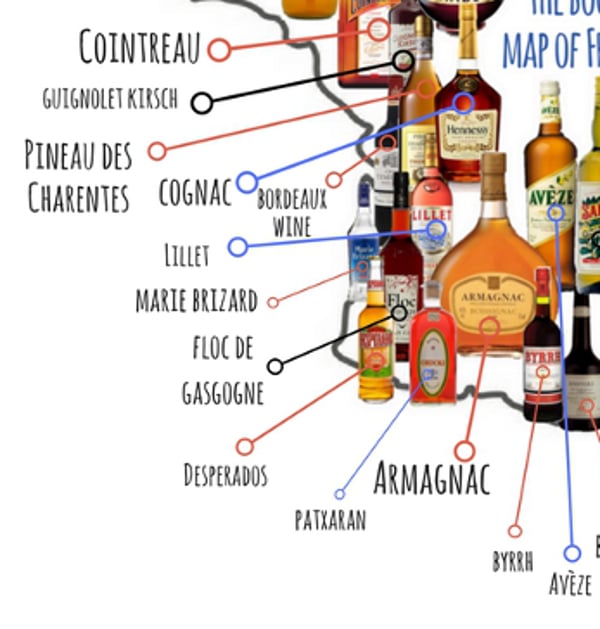
South west
Cointreau - The Cointreau brothers found success blending sweet and bitter orange peels and pure alcohol from sugar beets, with around 13 million of the iconic bottles sold a year. As for how they make it? It's still a family secret.
Guignolet Kirsch - The deep red aperitif from Anjou is made by marinating cherries in alcohol with kirsch, a clear cherry liqueur. It owes its name to the guigne cherry, one of the varieties used in preparation.
The drink was created by brothers Adolphe and Edouard Cointreau, who then went on to make the eponymous orange liqueur.
Cognac - The brandy, named after the town where it originates in Charente, is one of France's biggest drink exports.
When in town you can visit Hennessy's headquarters for tours and - of course - tasting.
Traditionally an after-dinner drink, the industry managed to successfully revamp its rather stuffy image and now brands like Hennessay and Courvoisier are hugely popular among younger people in the USA, with Courvoisier even featuring in the title of a Busta Rhymes track.
Pineau des Charentes - Often referred to as Cognac's little brother Pineau is a fortified wine, hugely popular in the west and works great as an aperitif. It's available in red or white.
Bordeaux wine - Along with Burgundy this is France's other key wine producing region. Bordeaux wines are made up of a blend of grape varieties rather than just one per wine.
Bordeaux varieties include Cabernet Sauvignon, Merlot and Sauvignon Blanc.
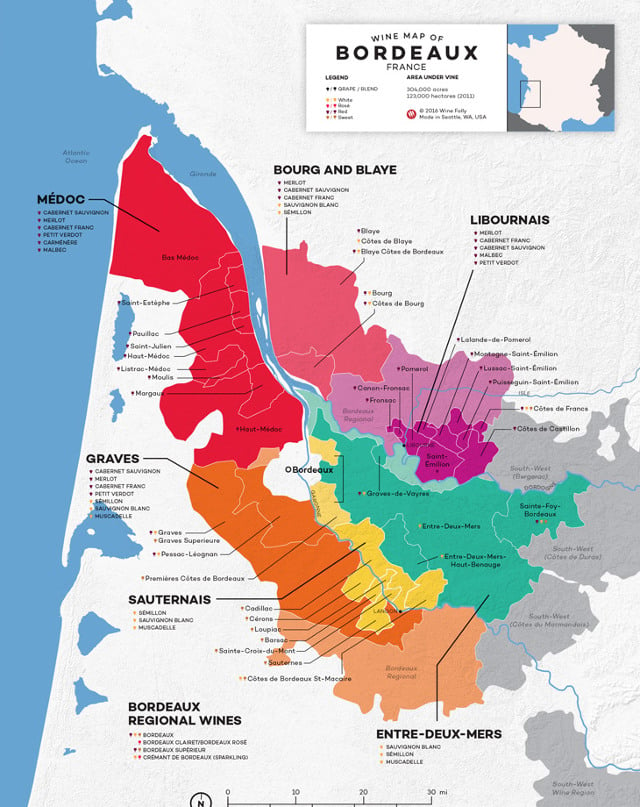
Lillet - Raymond and Paul Lillet concocted the Lillet aperitif in Podensac, near Bordeaux. Called Kina Lillet until the 1970s it's a blend of wine and fruit syrups and comes in red, white and rosé. It's particularly good as a summer drink with lots of ice and a slice of cucumber and is the preferred drink of serial killer Hannibal Lecter in Thomas Harris' books.
Marie Brizard anisette - The Marie Brizard brand now produces a variety of different drinks, but the original anisette liqueur from Bordeaux is the iconic label.
The recipe for the green anise flavoured drink is a closely guarded secret and remains unchanged since Marie Brizard herself finalised the recipe in 1763.
Floc de Gascogne - A light and fruity aperitif from Gascony, Floc de Gascony is made with grape juices and Armagnac. You can find it in white or red varieties.
Desperados - Now brewed in Alsace, the Tequila-flavoured beer is said to have been first created in France's Basque county in 1995.
Paxtaran - This drink from the Basque country is mainly associated with Spain, but can be found in the French part of the Pays Basque too.
Armagnac - Produced in the Armagnac region of Gascony the white wine grape-based brandy is similar to the more well known Cognac.
To detect all the flavours in Armagnac, it's sometimes advised to dab a drop on the back of your hand, wait for it to dry and sniff for notes of dried fruits, butterscotch and licorice.
Byrrh - The French vermouth was created in Thuir, close to the Spanish border. Based on red wine, it's a mild apéritif flavoured with quinine, coffee and bitter orange among other flavours.
Avèze - Produced in Riom-ès-Montagnes in Cantal, Auvergne, the liqueur is flavoured with wild yellow gentian plant from the area.
Did we miss out your favourite tipple? Share it with us at [email protected]. Santé!
Comments (4)
See Also
There are dozens of good maps of France (from the cheese map to the map that shows how many cheek kisses you should do) - but have you ever seen a good booze map?
We hadn't either, so decided to put one together. We present: The ultimate booze map of France, featuring most famous French tipples (no doubt we might have missed a couple) and a few you may not have heard of, let alone tried.
Of course you can try most of these alcoholic drinks anywhere in France, but we've focused on the area of the country each beverage originated in.
Here's the full map, followed by a closer look at each corner of the country.
(The Local France encourages responsible drinking and would suggest not all of these are sampled during the same apéro)


North west and west
Chambord - A popular addition to sweeten Champagne, the raspberry and blackberry liqueur is said to have been created when Louis XIV visited the Chateau de Chambord in the Loire Valley in 1685.
Lambig - Similar to Calvados, the apple brandy is also known in Brittany as "fine Bretagne". The cider is distilled in an alembic, which is from where the name originated.
Amorik Whisky - The Armorik range of whisky offers single malts and blends, made in what one distillery says are the perfect conditions of Brittany: "Our whisky has found a coastal heathland environment perfect for ageing under the best possible conditions. The sea, wind and rain have forged its character that is second to none."
Melmor - Similar to mead, this drink is a simple mix of water, honey, and yeast. If you like a drink with heritage, this one is for you - "The recipe has not changed since the Celts introduced chouchen to Brittany," one distillery claims.
Breton cider - Breton cider needs no introduction. If you're a real fan, take on the route de cidre - a tour of the region's cider makers. Inhabitants of Brittany also have a fierce and long-running dispute with their neighbours in Normandy over whether cider should be drunk from a glass or a cup.
Pommeau and Calvados - Over in Normandy, enjoy apple-based drinks like Calvados apple brandy, or try it mixed with apple juice in Pommeau.
Benedictine - Here's another Normandy speciality made with apples. The drink is said to have been created by the Benedictine monk Dom Bernado Vincelli in Fécamp Abbey in 1510. The "elixir" recipe was lost for 350 years and re-discovered by Alexander the Great, who named it Bénédictine.

North east
Grey Goose vodka - The famous Grey Goose vodka is distilled in Picardy, close to the Belgian border. Although the drink was created by American Sidney Frank, it uses the soft wheat from the Picardy area and is fermented and distilled in the area before being sent to the Cognac region for bottling. The bottle shows the French flag, just to big-up the brand's French connection.
Grand Marnier - One of France's most successful alcoholic exports, the orange-flavoured liqueur Grand Marnier is made with a blend of Cognac and bitter oranges, coming from from Neauphle-le-Château near Versailles.
Pelforth - This beer, which comes in blonde and brown varieties, originated from Lille and now belongs to the Heineken group.
Champagne - No surprises for guessing where Champagne comes from. All "official" Champagne still comes from the Champagne region of France. The wine collectives of this area employ a team of eagle-eyed lawyers to track down and threaten (with a lawsuit) anyone attempting to market a product with 'Champagne' in its name if it does not contain some product from the area.
Ratafia - Ratafia refers to fortified wines or liqueurs or citrus-peel flavoured liquers. The ratafia from Champagne is the most famous and is of the fortified wine category. It's made with the same grapes as for champagne, but they're allowed to ripen to maturity, dried, and re-hydrated.
Mirabelle liquer - Yellow "mirabelle" plums are a delicacy of the Lorraine region and appear in many local recipes. The plum liqueur is sweet and slightly honey-flavoured.
Burgundy wine - The mineral taste of Burgundy wines comes from the area's limestone soils, formed at a time when Burgundy was part of a tropical sea. The two main Burgundy grapes are Pinot Noir and Chardonnay. Obviously there are too many Burgundy wines to get on this map.
Fischer beer - Ficher beer, in its distinctive corked bottle, is native to Alsace. The Fischer brewery was founded in Strasbourg and moved to Schiltigheim. The north-east of France is the country's beer heartland, although good craft ales are becoming increasingly popular through the rest of the country too.
READ ALSO How France became a nation of beer lovers
Kronenbourg - Another Alsacian beer, Kronenbourg was created in Strasbourg and its 1664 variety is now the most sold French beer in the world.
Pernod - This aniseed liqueur, created around 80 years ago, is one of the hallmarks of French drinking. When served with ice and water the clear liquid turns a cloudy cream colour - and is perfect for a summer's day. Although it's technically not a Pastis.
Vieux Pontarlier - The French absinthe from Pontarlier, close to the Swiss border, is still made using the original recipe. It's made from local wormwood, green anise seeds and fennel seed along with a secret blend of herbs and spices. Fun fact: none of the ingredients in absinthe are hallucinogens and never were.
READ ALSO How the 'absinthe murders' lead to a global ban

Crème de cassis - The sweet blackcurrant liqueur is a speciality of Burgundy and Dijon in particular. It's normally mixed with white wine to make a Kir. If you mix it with sparkling white wine, that is a kir royale - both drinks are often enjoyed as an apéro.
Chartreuse - Chartreuse boasts that its herbal liqueur is the only one in the world with a completely natural green colour.
The history of Chartreuse is a bit of a mystery, in 1605 a Chartreuse monastery apparently received a gift of an ancient manuscript containing the recipe for the drink. It was sent to the order's main monastery near Grenoble where it was deciphered, recreated and sold as a medicine called "The Elixir of Long Life".
Of course it's possible that this story was dreamed up by a 17th century monk who had a gift for marketing.
Rinquinquin - The Provencal drink is made with peaches, autumnal peach tree leaves, cane sugar and Lubéron white wine. You can drink it as an aperitif with tonic, neat or with ice cubes.

South west
The drink was created by brothers Adolphe and Edouard Cointreau, who then went on to make the eponymous orange liqueur.
Cognac - The brandy, named after the town where it originates in Charente, is one of France's biggest drink exports.
When in town you can visit Hennessy's headquarters for tours and - of course - tasting.
Traditionally an after-dinner drink, the industry managed to successfully revamp its rather stuffy image and now brands like Hennessay and Courvoisier are hugely popular among younger people in the USA, with Courvoisier even featuring in the title of a Busta Rhymes track.
Pineau des Charentes - Often referred to as Cognac's little brother Pineau is a fortified wine, hugely popular in the west and works great as an aperitif. It's available in red or white.
Bordeaux wine - Along with Burgundy this is France's other key wine producing region. Bordeaux wines are made up of a blend of grape varieties rather than just one per wine.
Bordeaux varieties include Cabernet Sauvignon, Merlot and Sauvignon Blanc.

Lillet - Raymond and Paul Lillet concocted the Lillet aperitif in Podensac, near Bordeaux. Called Kina Lillet until the 1970s it's a blend of wine and fruit syrups and comes in red, white and rosé. It's particularly good as a summer drink with lots of ice and a slice of cucumber and is the preferred drink of serial killer Hannibal Lecter in Thomas Harris' books.
Marie Brizard anisette - The Marie Brizard brand now produces a variety of different drinks, but the original anisette liqueur from Bordeaux is the iconic label.
The recipe for the green anise flavoured drink is a closely guarded secret and remains unchanged since Marie Brizard herself finalised the recipe in 1763.
Paxtaran - This drink from the Basque country is mainly associated with Spain, but can be found in the French part of the Pays Basque too.
Byrrh - The French vermouth was created in Thuir, close to the Spanish border. Based on red wine, it's a mild apéritif flavoured with quinine, coffee and bitter orange among other flavours.
Avèze - Produced in Riom-ès-Montagnes in Cantal, Auvergne, the liqueur is flavoured with wild yellow gentian plant from the area.
Did we miss out your favourite tipple? Share it with us at [email protected]. Santé!
Join the conversation in our comments section below. Share your own views and experience and if you have a question or suggestion for our journalists then email us at [email protected].
Please keep comments civil, constructive and on topic – and make sure to read our terms of use before getting involved.
Please log in here to leave a comment.